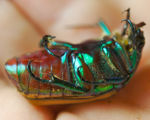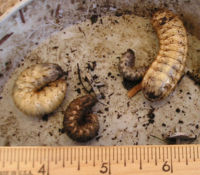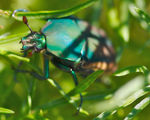June bug
| June bug |
|---|

|
| Scientific Classification |
|
| Binomial Name |
|
Cotinis mutabilis |
The June Bug is a species of beetle (Cotinis mutabilis) also known as the "Figeater beetle", "June beetle", and the "Fig eater". June bugs are member of the scarab beetle family (Scarabaeidae). A different genus (Phyllophaga) contains the nocturnal beetles referred to as June bugs in the eastern U.S.A.
People can be confused between June Bug and the Rose Chafer (Cetonia aurata), which are alike in color, but a little bit smaller. People also can be confused between the June Bug and the European chafer (or "European June Bug"). Though their life cycles are very different, all of them are scarabaeidae, and have larvae that are white grubs.[1]
Anatomy
When they become imagoes (an imago is an adult beetle), their sizes range from 2 cm to 3.5 cm [0.8 to 1.35 inches]. While larvae, they are white and grow to about 5cm [2 inches], with short hornlike projections on their heads. People can easily recognize adult beetles, since most of their bodies are bright green[2] (their underside is shining green or gold). They hum noisily, and work during the day. Other beetles, such as brown May or June beetles, fly into lights on summer nights while the June bug flies only in the daytime.
The larva of the June bug is a white grub usually found in compost or decaying matter. When they move, they use their thorax for moving instead of legs. Ripe larvae make empty spaces in the soil and pupate there. Adults lay eggs in the fall, which become larvae which pupate in June and new adults emerge between July and August. There is one stage every year.[3]
[edit]
Natural History
The larval grubs feed on natural substances, often overripe figs or peaches, and grow fast. When the larvae infest lawns they can damage the roots.
Warmth given off by the decaying plant matter permits the beetles to stay energetic the whole year. The grubs tumble on their backs to escape when uncovered. Throughout the spring, grubs hollow out rooms under the earth where they pupate. After a few months, the mature beetles form wings and emerge.
The june bug can eat over-mellow or damaged grapes, peaches, and figs, unfortunately their mouthparts are ineffectual, so they can't chew most other plants well until the plants or fruits are damaged by other insects. Thus, most natural plants are seldom harmed at first by the beetles, though they are often blamed for damage done by other insects because they take advantage of it. [4]
During early summer and fall, these queer and large green beetles can be seen near San Diego, though usually they appear later in other areas. Thirty years ago, they were less common, but modern composting techniques encourage them. The beetles now abound in the earth of the southern U.S.A., laying their eggs during the fall in rotting plant substances, especially in compost and backyard piles of decay [5]. The grubs do cause lawn damage and where this occurs people are encouraged to cover compost, or turn it often so birds can find and eat the grubs.
Ecology
Larvae live in the surface of soil, avoiding the cold deep in the soil. In the spring, they burrow through the soil to find food. Eggs remain in the soil during the winter, hatch into larvae in the early spring, and pupate in late spring or early summer.
 Browse |
Related References
- Figeater beetle by Wikipedia
- Cotinis mutabilis: Green Fruit Beetle, Figeater Beetle San Diego Natural History Museum



